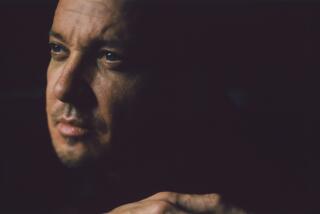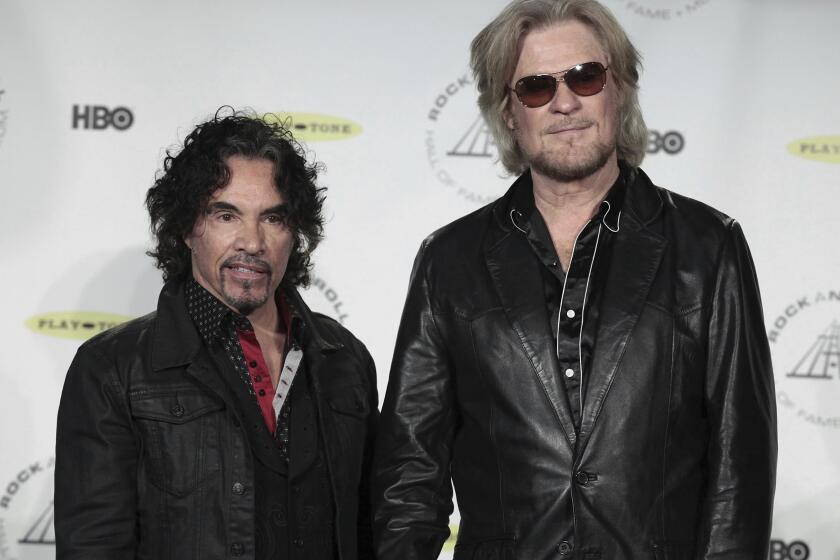A medium in motion
The essence of telling stories with moving pictures has changed little since the earliest days of cinema. But the story of Hollywood is punctuated by technological innovations that opened new paths for directors, actors, writers and audiences. And as Times staff writer Dawn C. Chmielewski explains, change has rarely come easily -- or without a fight.
*
Moving pictures
Thomas Alva Edison wrote in 1894 that he wanted to “do for the eye what the phonograph does for the ear.” And Hollywood often credits him with inventing the first motion picture camera, the Kinetograph. His work was influenced by British photographer Eadweard Muybridge, who 22 years earlier developed a crude photographic system of cameras and trip wire called the Zoopraxiscope to settle a bet: whether all four of a horse’s feet leave the ground simultaneously when it gallops. (They do.) Edison also built the first motion picture studio: the “Black Maria,” a tar paper shack with a hole in the roof that was on a turntable so it could rotate to follow the sun. But Edison didn’t think audiences would pay to watch films. Brothers Louis and Auguste Lumiere assembled a Parisian audience in 1895 to witness their creation, a camera/projector called the Cinematographe, which led to the birth of theatrical exhibition.
Synchronized sound
Silent films were far from silent. Pianos and orchestras accompanied the action on-screen. Edison tried in 1913 to synchronize sound with a giant version of his phonograph behind the screen. It was synchronized with the projector using a string belt suspended over the audience. Lee de Forest is frequently credited with recording sound directly on film. His Phonofilm was publicly demonstrated at the Rivoli Theater in New York City in April 1923 -- four years before Al Jolson’s “The Jazz Singer.” But silent film was at its apex. Who needed sound? On Aug. 6, 1926, Warner Bros. opened “Don Juan” using a technology called Vitaphone. The musical accompaniment was recorded on wax records. It was a rousing success. Warner then released “The Jazz Singer,” followed by the first all-talking picture, “The Lights of New York.” By the 1930s, the Hollywood pantomime party was over and such icons as Buster Keaton and Charlie Chaplin were left out of the limelight.
Color
Color didn’t explode suddenly on the screen, like Dorothy stepping out of a black-andwhite Kansas into a colorful Oz, donning her ruby red slippers. Filmmakers initially added color by hand -- employing legions of women who would painstakingly retouch each frame. In 1922, a pair of Massachusetts Institute of Technology graduates pioneered the three-color system that became synonymous with the company they founded, Technicolor. The 1935 film “Becky Sharp” was the first movie to be shot with this new full-color process, using a camera with three strips of black-and-white film. A prism split the light into red, green and blue. The colors were recombined through a complicated printing process, in which one color was laid on top of another. Filmmakers would later credit color as adding a dimension of reality. “It may be garish, it may be unreal, and it’s far from subtle, but it’s alive,” director Martin Scorsese wrote of Technicolor.
Television
Philo T. Farnsworth came up with the idea for modern television while plowing his father’s potato field. An avid reader of scientific journals and an admirer of Albert Einstein, the 14-year-old Farnsworth envisioned sending electrons in rows -- just as one would plow a field. By age 20, he had opened his first laboratory above a garage in San Francisco and a year later, in 1927, he filed his first patent for a television system. David Sarnoff, founder of the NBC radio network, directed his RCA laboratories to investigate ways to transmit a moving image. RCA trumped Farnsworth in the market as television flourished after World War II. The U.S. electronics industry, which had expanded to meet wartime demands, turned its efforts to peacetime applications. By 1950, TV was pinching cinemas. Attendance nose-dived and theaters closed -- foreshadowing today’s tension between multiplexes and home theaters.
Really big screens
To fight off the threat of television, theaters in the 1950s revived technologies developed years earlier to attract audiences -- such as bigger screens than those that could be filled by traditional 35mm film. At the Paris International Exhibition of 1900, 10 synchronized projectors displayed images on a giant curved screen. In 1927, Frenchman Abel Gance directed “Napoleon” using three synchronized cameras. During World War II, the technology was adapted to train antiaircraft gunners. CinemaScope used lenses that compressed the image during filming and expanded it during projection. Others experimented with 70mm film -- a larger film that would play on standard projectors, but recorded four times as much information and afforded even wider picture presentation. It produced such spectacles as “Oklahoma!” and “Lawrence of Arabia.” Today, 70mm film is mostly used in IMAX large-format presentations.
Ideas that sounded good
The 1952 jungle adventure “Bwana Devil” was the first to feature 3-D effects -- lunging lions and hurled spears aimed at the audience -- drawing on experiments in still photography from the late-19th century. Movies that made images pop off the screen were filmed with two side-by-side cameras; the two filmstrips were then combined for projection. To sort out the visual jumble on-screen, special glasses (usually with polarized lenses) separated the images again -- one for the right eye, one for the left -- to create the illusion of 3-D. Swiss professor Hans Laube’s Smell-O-Vision used tubes under seats to pipe odors into theaters. After the 1960 film “Scent of Mystery,” a Time magazine critic wrote, “Customers will probably agree that the smell they liked best was the one they got during intermission: fresh air.” “SenSurround” debuted with the 1974 premiere of the movie “Earthquake” It added air vibrations to the soundtrack that triggered audible and sub-audible effects.
Home video
The Motion Picture Assn. of America’s former frontman Jack Valenti predicted the 1975 introduction of Sony Corp.’s Betamax videotape recorder would do to the American film industry what “the Boston Strangler did to a woman alone.” Hollywood sued to have recorders taken off the market, but in 1984 the U.S. Supreme Court ruled against the studios. Betamax lost out in the market to the more popular VHS. But the real winner was Hollywood. Home video sales accounted for 46% of studios’ revenue in 2005, according to Adams Media Research -- double their box office receipts. The 1997 debut of the DVD, or digital versatile disc, was among the most successful consumer products ever introduced -- finding its way into more than half of all American households in just six years. A replay of the Betamax-VHS format war is brewing over the successor to DVD, high-definition video discs with surround sound. Two rival and incompatible formats, Blu-ray and HD DVD, are starting to hit stores.
Visual effects, animation
French director Georges Melies incorporated special effects in his 1902 film “Le Voyage dans la Lune” (A Trip to the Moon) -- including double-exposure, split screens, miniatures and stop-action. Animation was born in 1914 with Winsor McCay’s “Gertie the Dinosaur.” Walt Disney’s groundbreaking “Snow White and the Seven Dwarfs” in 1937 was the first full-length, hand-drawn animated film. A giant ape marked another cinematic special effects milestone: 1933’s “King Kong” employed matte paintings, miniatures, rear projection and stop-motion animation to create scenes such as Kong’s death atop the Empire State Building. The work inspired effects master Ray Harryhausen, whose creatures populated “The Golden Voyage of Sinbad” and “Jason and the Argonauts.” Industrial Light & Magic revolutionized special effects with 1977’s “Star Wars,” and Pixar added a new dimension to animation with the computer-generated graphics of 1995’s “Toy Story.” Now, most effects are created with high-power computers.
Online distribution
Internet file-swapping pioneer Napster in 1999 introduced millions of people to the ease of downloading songs to their computer. It didn’t take long for the peer-to-peer phenomenon to spread to TV and movies. As with Betamax, Hollywood sued, this time to hold file-sharing networks liable for the piracy of their users. This time, Hollywood won. And as they did with home video 20 years ago, the studios are starting to embrace technology they once feared. In fall 2002, a group of movie studios started an online video-on-demand service, Movielink, though it got off to a rocky start with a lack of timely movie releases and promotion. Meanwhile, online video distribution is gaining momentum. Apple Computer Inc.’s iTunes Music Store began to sell downloads of popular TV shows in 2005. Premium cable provider Starz Entertainment Group LLC now has its own online service, Vongo, which offers pay-per-view movies. And just this month, Warner Bros. launched a movie distribution deal with file-sharing company BitTorrent Inc.
More to Read
The biggest entertainment stories
Get our big stories about Hollywood, film, television, music, arts, culture and more right in your inbox as soon as they publish.
You may occasionally receive promotional content from the Los Angeles Times.






